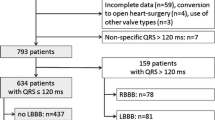Abstract
Background
First-degree AV block has in the past generally been considered a benign condition. A few recent studies have shown that 1st-degree AV block is associated with an increased risk for heart failure, pacemaker (IPG) implantation, and death. We investigated the outcomes of patients who received an insertable cardiac monitor (ICM) (Medtronic Reveal XT®) within the scope of the INSIGHT XT study and had 1st-degree AV block at baseline.
Methods
The observational, international, multi-center INSIGHT (R)XT study prospectively enrolled 1003 patients implanted with an ICM for arrhythmia diagnosis, irrespective of the clinical indication. This analysis includes 37 patients who had documented 1st-degree AV block at enrolment. Patients with known concurrent higher grade block at enrolment were excluded.
Results
The indications for rhythm monitoring and ICM implantation were syncope/pre-syncope in 54.1%, cryptogenic stroke in 18.9%, AF with rhythm control intervention in 21.6%, and unexplained palpitations in 5.4%. Mean age was 68 ± 14 years, 75.7% were male, and concurrent bundle branch block was present in 8.1%. The median follow-up time was 12.2 months (IQR3.9–15.9). Fifteen patients (40.5%) received an IPG during the follow-up, and in 93.3% of the cases, the implant was needed to treat a now detected more severe bradycardia or progression of the conduction disease.
Conclusions
ICM either revealed progression of 1st-degree AV block to a higher grade block (53%) or detected an already existing more severe bradycardia warranting an IPG in 40.5% patients. This finding supports the conclusion that 1st-degree AV block might be a risk marker for more severe intermittent conduction disease and is not benign in all patients. Further studies may reveal patient subgroups which are at risk for demonstrating or developing higher grade AV block and may warrant a future IPG implantation.

Similar content being viewed by others
References
Packard JM, Graettinger JS, Graybiel A. Analysis of the electrocardiograms obtained from 1000 young healthy aviators: ten year follow-up. Circulation. 1954;10:384–400.
Johnson RL, Averill KH, Lamb LE. Electrocardiographic findings in 67,375 asymptomatic subjects. VII. Atrioventricular block. Am J Cardiol. 1960;6:153–77.
Bexton RS, Camm AJ. First degree atrioventricular block. Euro Heart J. 1984;5(Suppl A):107–9.
Erikssen J, Otterstad JE. Natural course of a prolonged PR interval and the relation between PR and incidence of coronary heart disease. A 7-year follow-up study of 1832 apparently healthy men aged 40–59 years. Clin Cardiol. 1984;7:6–13.
Mymin D, Mathewson FA, Tate RB, Manfreda J. The natural history of primary first-degree atrioventricular heart block. N Engl J Med. 1986;315:1183–7.
Cheng S, Keyes M, Larson M, McCabe E, Newton-Cheh C, Levy D, et al. Long-term outcomes in individuals with prolonged PR interval or first-degree atrioventricular block. JAMA. 2009;301(24):2571–7.
Uhm JS, Shim J, Mun HS, Park J, Park SH, Joung B, et al. First-degree atrioventricular block is associated with advanced atrioventricular block, atrial fibrillation and left ventricular dysfunction in patients with hypertension. J Hypertens. 2014;32:1115–20.
Crisel RK, Farzeneh-Far R, Beeya N, Whooley MA. First-degree atrioventricular block is associated with heart failure and death in persons with stable coronary artery disease: data from the heart and soul study. Eur Heart J. 2011;32:1875–80.
Kwok CS, Rashid M, Beynon R, Barker D, Patwala A, Morley-Davies A, et al. Prolonged PR interval, first-degree heart block and adverse cardiovascular outcomes: a systematic review and meta-analysis. Heart. 2016;102(9):672–80.
Funding
This study was supported by Medtronic.
Author information
Authors and Affiliations
Consortia
Corresponding author
Ethics declarations
Conflict of interest
Thorsten Lewalter has received speaker honorarium from Medtronic.
Helmut Pürerfellner has received speaker honorarium from Medtronic.
Andrea Ungar has received speaker honorarium from Medtronic.
Guido Rieger is an employee of Medtronic.
Lorenza Mangoni is an employee of Medtronic.
Firat Duru has received speaker honorarium from Medtronic.
Rights and permissions
About this article
Cite this article
Lewalter, T., Pürerfellner, H., Ungar, A. et al. “First-degree AV block—a benign entity?” Insertable cardiac monitor in patients with 1st-degree AV block reveals presence or progression to higher grade block or bradycardia requiring pacemaker implant. J Interv Card Electrophysiol 52, 303–306 (2018). https://doi.org/10.1007/s10840-018-0439-7
Received:
Accepted:
Published:
Issue Date:
DOI: https://doi.org/10.1007/s10840-018-0439-7




